5 Things Craft Show Shoppers Shouldn’t See
When I first started selling at craft fairs, it was all about ME.
>> The products I wanted to make
>> The display that was easiest for me to create
>> Letting people shop in silence because I didn’t feel comfortable selling
But when I started putting the shopper/customer first, my business changed for the better.
I sold more at events, saw an increase in sales after events, attracted wholesale orders, and running my handmade business became easier.
These 5 don’ts put the shopper first and may help you view things from their perspective.
Don’t #1 – Showcasing everything you can make
Conveniently, my “best” product ideas would come the day before a craft show and keep me up until 2 a.m. making “just one more”.
In the beginning, my craft show table was a mixture and rotation of everything from flannel pajama bottoms, rice heating bags and hand warmers, pillows, aprons, burp cloths, mittens, and a variety of bags.
I was focused on what I could and wanted to make, instead of the way consumers shop and what they typically buy together.
Consumers don’t tend to shop for pajamas and purses simultaneously. They either shop for sleepwear/loungewear or items to accessorize an outfit.
Someone might buy:
>> pajama bottoms + a pajama top + a sleep mask
>> a new handbag + a matching wallet + keychain.
>> an apron + oven mitts
But a shopper is unlikely to buy a pair of pajama bottoms and a new wallet in the same transaction.
When I added more types of products, I took away opportunities for customers to buy more than one item.
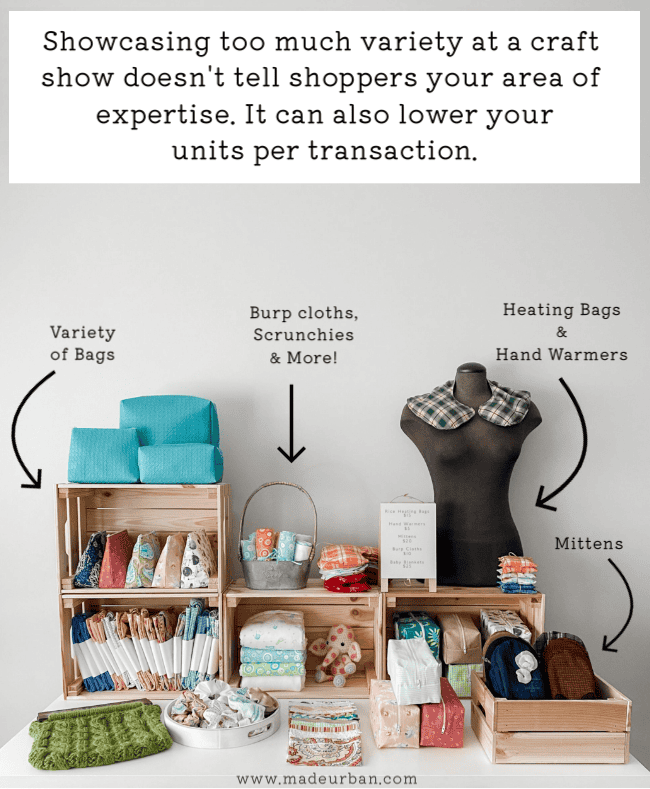
I used to think: The more types of products I offered, the more likely someone would find something to buy. But your creativity is likely killing your sales.
As this study proves, more variety can lead to shoppers being overwhelmed and experiencing decision fatigue, which in turn leads to fewer shoppers buying.
Your craft show table should have a (shopping) theme.Such as:
>> winter accessorizing -> or niched down to bohemian winter accessories
>> home decorating -> or niched down to modern farmhouse door wreaths
>> bath & body -> or niched down to men’s beard care
When you try to offer too many types of products (e.g. jewelry, knitted goods, candles, soaps, etc.) or too much variety (e.g. metal jewelry, wire-wrapped jewelry, crystal jewelry, plastic beaded jewelry, etc.) you confuse shoppers.
- They don’t know how to pair items together
- They have a hard time deciding between so many types of products
- They don’t know your area of expertise.
- They question the quality of your products (i.e. “can one person really be skilled at creating soap, jewelry, AND knitting? Or is that soap going to give me a rash and will that jewelry fall apart?”).
- They don’t feel like your products/business/brand are made for them.
Can you make sales when you have a variety of items on your craft fair table? Absolutely.
But from my experience, I made one-time sales from shoppers who wanted to buy something small at the craft show.
- I didn’t build a loyal following
- I didn’t have many people investing in a bigger/higher-priced item
- I didn’t sell multiple items in one sale (i.e. one shopper buying multiple items…here’s how you can increase how many items each shopper buys)
- I couldn’t charge premium prices
Don Fisher is an example of a company that has grown a successful business by focusing on one type of product (bags/cases) and even a niche within that category (fish-themed bags/cases). Here they are in their earlier days at a craft show:
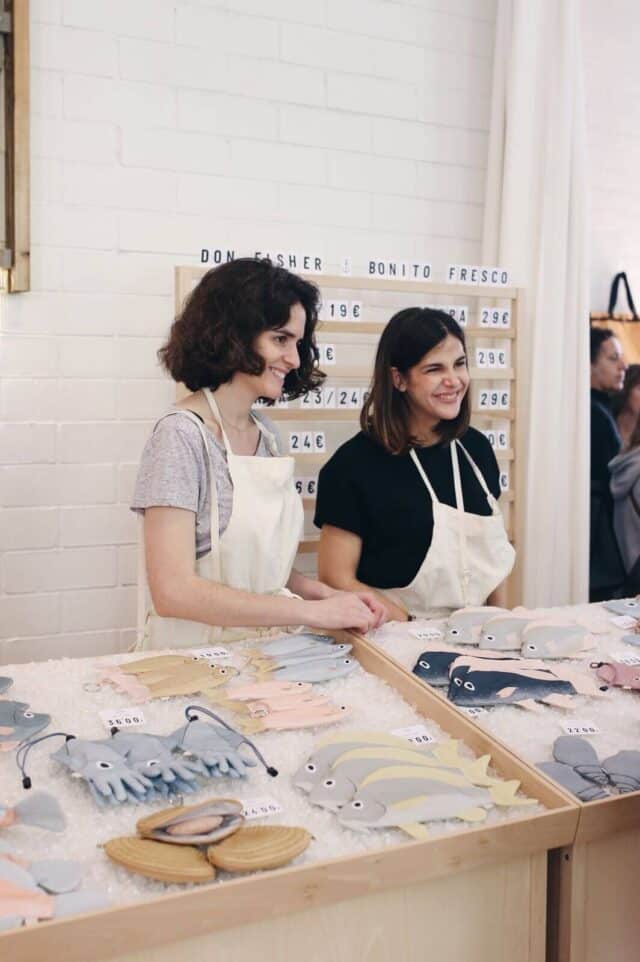
Show shoppers what you’re great at making, what your passion is, and why they should buy from you, by keeping your product selection limited.
A craft show display with too much variety also starts to look cluttered and messy. Sticking to 3 – 5 types of products, colors, materials, etc. keeps your display looking and feeling cohesive.
Don’t #2 – Items that don’t showcase your unique style
Once I started focusing on one category of products (bags), I had more shoppers stopping at my table and made more sales. But I still had work to do.
Even within the bag category, I was offering too many options, branching into too many subcategories, and didn’t have a signature style or USP (unique selling position).
>> Here’s how to create a signature style: How to Develop a Signature Style for your Handmade Business
>> Here’s how to uncover your USP: How To Find a USP for your Handmade Business
I was just another vendor selling tote bags, shoulder bags, crossbody bags, clutches, and coin purses in a variety of materials.When I started selling my weekend bag it was like flipping a switch. That bag caught shoppers’ attention and they would go straight to it. There was a sense of urgency from shoppers to buy it, it would be the first style to sell out, and people were pre-ordering weekend bags while at the craft show. Not to mention, retailers approached me asking to carry my products.
I didn’t have to reinvent the wheel; I just had to create something that was above and beyond what the average bag vendor was selling.
The more I focused my product line around that weekend bag, the more sales I made.
I got rid of the clutches, the crossbody bags, and the endless styles of totes. I stopped buying the same materials my competitors were using, and focused on one subcategory of bags; travel bags.
A soap vendor might offer something a little out of the ordinary by focusing on less common scents.
While most soap vendors offer plant-based scents (lavender, lemon, eucalyptus, etc.), I could focus on candy-scented soaps. That simple shift makes my craft show booth stand out.
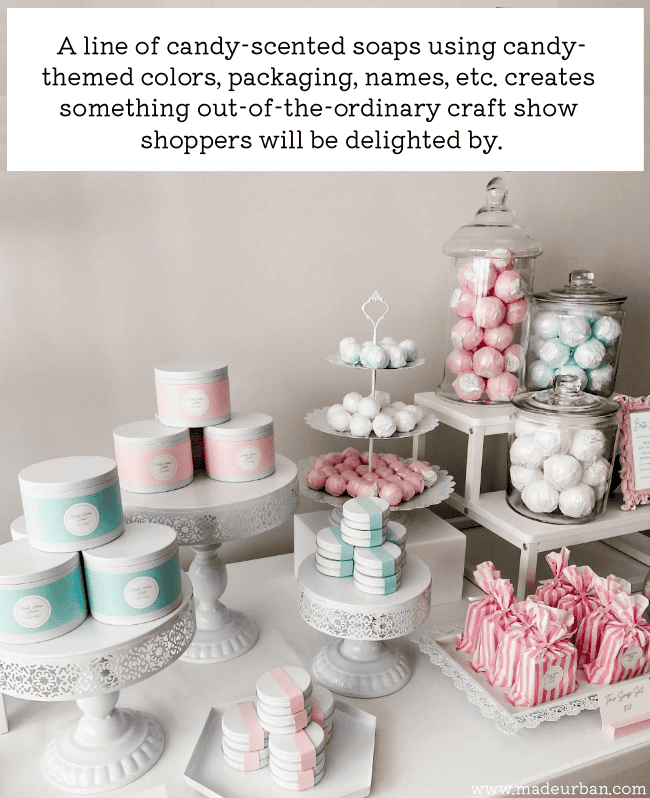
Even the way you present your products can give the perception you’re offering something different.
- Group products in a unique way – grouping by color can create a different vision/inspiration/feeling (here’s how to create product groupings on your craft show table). For example, highlighting pastel colours in a scarf display can give the scarves a feminine feel when every other winter accessory booth is showcasing a wide variety of colors.
- Use props and signage that tell a unique story – for example, a jewelry vendor could stand out by adding props that help tell a story about WHERE the jewelry might be worn. Such as beach elements for casual jewelry that might be worn to the beach, or Christmas-themed elements for jewelry that might be worn to Christmas parties and dinners.
- Highlight a benefit your competitors aren’t – for example, many soap vendors sell “cold-processed soap” but not many vendors explain WHY that’s a benefit. If every vendor is advertising “cold-processed soap” and one vendor is advertising “Gentle skincare” or “Environmentally friendly soap” they will stand out to shoppers.
Don’t #3 – Disjointed display fixtures
At my first craft show, I gathered wicker Ikea baskets, plastic bins, a moss green jacquard tablecloth, and clear acrylic picture frames from around my home to use in my display.
Although it was a good way to save some money, it created a disjointed display that distracted shoppers from my products.
You don’t have to spend a lot of money, but you should be strategic when choosing items for your display.
If you’re borrowing items from your home, stick to one (or two) materials/finishes.
For example, I should have used wicker baskets OR plastic bins, but not both. If I had gone with wicker baskets, I could have used wood picture frames for signage, instead of my modern clear acrylic frames.
You can also shop your local thrift store or dollar store to find fixtures and props that work together, without blowing your budget.
Another option is using spray paint to make a variety of fixtures look more cohesive.
Taking a black wire basket, wood crate, and wicker tray and spray painting them all white will instantly make a craft show display look more professional and pulled together.
As you sell at more craft shows, put a portion of your profits towards new fixtures.
I hated having to put my living room back together after an exhausting craft show. It was much more convenient to keep all of my craft show props tucked away in a bin so I knew where everything was and could simply throw the bin in my trunk without having to ransack my house.
Don’t #4 – A display with no story
The first craft show table I set up said: here’s some stuff I made…and some photos my friend took on the other end of the table.
I took a different direction at the next few craft shows and my table said: here’s a bunch of purses I made.
Because I had too many styles of purses, I didn’t communicate to shoppers:
- What type of woman were my purses for
- What style of wardrobe my purses would fit into
- Where my purses might be worn
- What they might be worn with
- What my bags might be used for (e.g. book bag? Diaper bag?)
The easier you make it for someone to imagine using your products, the easier it is for them to buy.
When I introduced my weekend bag, my craft show display went in a new direction. It slowly morphed into a “travel” story. People could imagine using my bags for a trip because the majority of items on my table told that story.
A good story is easy to follow and doesn’t jump around.
When my weekend bags were next to evening bags and beach bags, it was hard for shoppers to follow my message.
I was forcing shoppers to think about going to the beach one second, then accessorizing with a satin clutch appropriate for prom the next.
It created confusion and made it harder for a shopper to focus on making a purchase.
By simply focusing on one type of product, you can tell a “story”. For example:
>> Bags and cases one might use when packing for a trip, luggage tags, and passport wallets tell a “travel” story.
>> A table showcasing bohemian-style jewelry tells a “bohemian” or “music festival” story.
>> A bath and body vendor selling soap, bubble bath, bath salts, and candles tells a “bath time” or “relaxation” story.
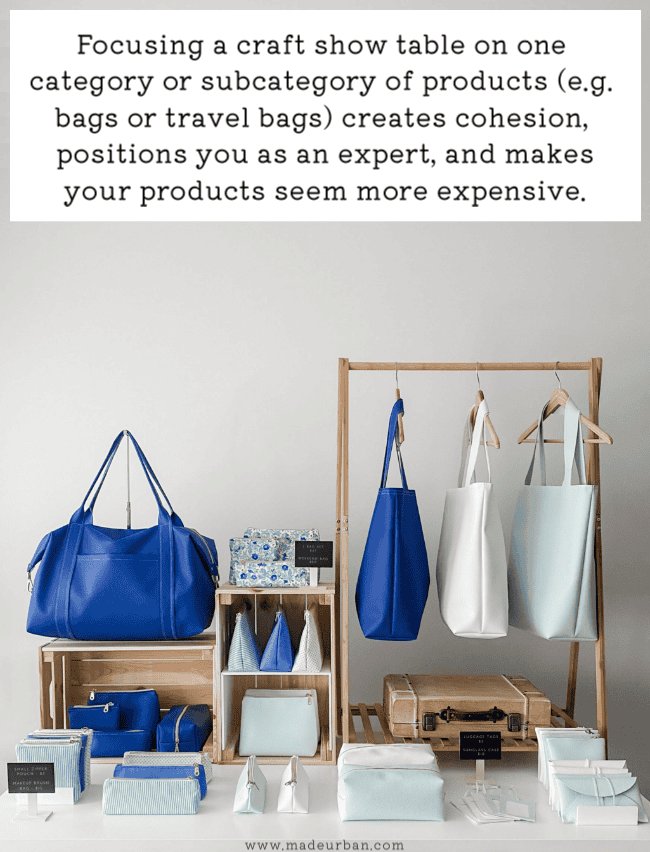
But you can also use props, fixtures, and signage to help communicate a story. For example:
>> Travel-themed props help communicate the “travel” story.
>> Using wicker display fixtures, adding ceramic vases with pampas grass, and wearing a boho dress and flower crown would help tell a “bohemian” story.
>> Adding rolled-up towels, a tabletop water fountain, and softly playing spa music would help tell a “bath time” or “relaxation” story.

Think about the details that surround your customers when using your products.
- Who are your customers? (specifically…e.g. not just “women”; what kind of women?)
- What are they doing when using your products?
- Where are they using your products and what are they surrounded by?
- When are they using your products? (e.g. time of day, week, year)
- Why are they using your products?
- What’s the benefit/goal they’re hoping to achieve?
- How do they want to feel when using your product?
These details can help you build a story, which you can then communicate through products, fixtures, props, colors, and signage.
Another way to think of your product/display/brand “story” is to consider:
- What inspired your products?
- How can you inspire shoppers?
- What’s the feeling you want to evoke?
- How can you spark shoppers’ imagination?
For example, let’s say I’ve created a candy-scented line of bath and body products. “Candy” inspired my collection and I might want my shoppers/customers to feel a sense of nostalgia when using my candy-scented soaps, or to evoke a feeling of fun.
By simply having a table full of candy-scented soaps (rather than some candy-scented, some floral-scented, some fruit-scented, etc.), I start telling my story.
But then I can start adding more elements that strengthen my story, such as:
- a candy-striped tablecloth or wearing a candy-striped apron
- repeating candy colors throughout my display (e.g. pink and white)
- using candy-themed packaging
- using display fixtures that might be used in a candy shop (e.g. candy jars)
- adding signage that has the look and feel of an old-fashioned candy shoppe
- adding candy props
- etc.
This display tells a “candy” story and makes my display and products feel more unique, special, and fun.
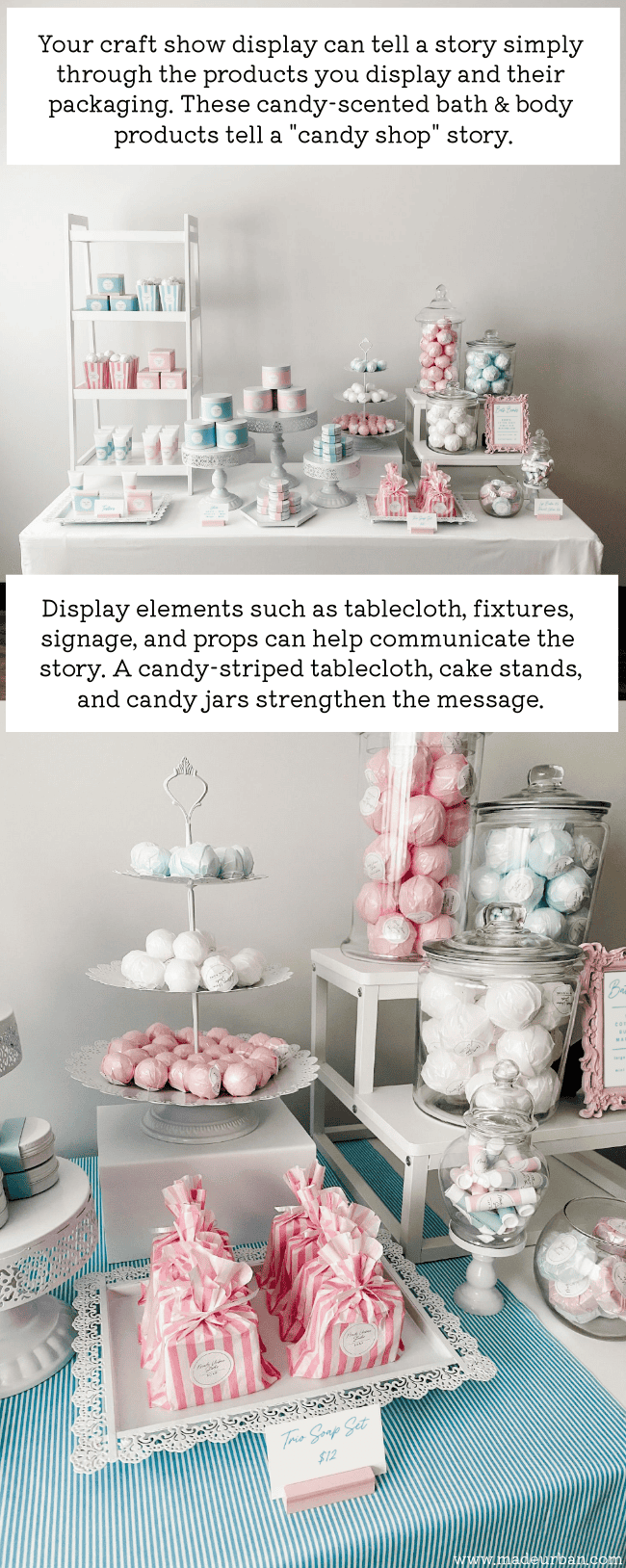
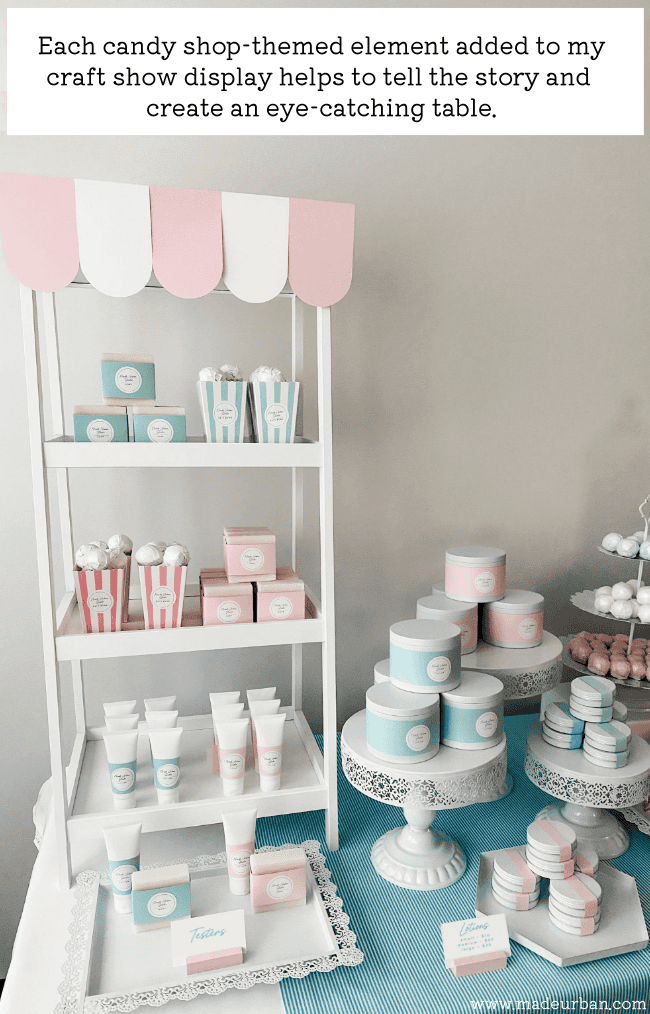
Don Fisher does a great job at markets telling a “fish market” story, basing it on the inspiration behind their bags (fish).
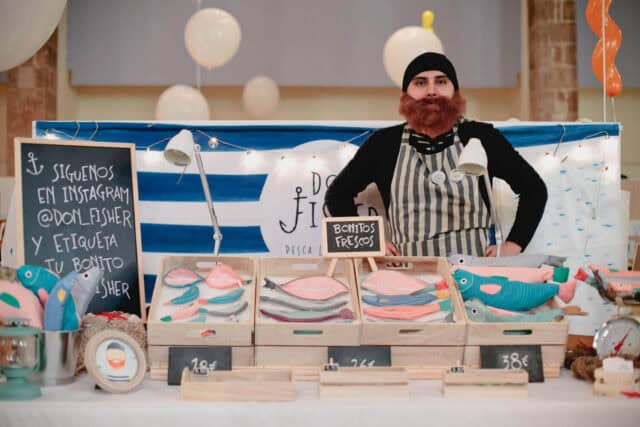
Don’t #5 – A vendor who doesn’t know how to sell
I spent my first few craft shows meekly saying “hi” and awkwardly watching people shop. I’m sure craft show shoppers didn’t appreciate it and my sales numbers reflected my lack of effort.
- Telling people about product features they can see for themselves was not helpful.
- Watching people shop and saying nothing while they were at my table was awkward.
- Looking at my phone or talking to other vendors while people were in my space was rude.
You’re not annoying people by selling your work.
Especially when you find the right way to sell.
You have to uncover the benefits people care about and share your story.
As explained in the soap example earlier; “cold-processed” doesn’t mean anything to most consumers. That’s a feature; not a benefit.
How does the customer benefit from cold-processed soap? A cold process may create a milder soap, which translates into “gentle cleansing that won’t dry out your skin”. That’s a benefit consumers care about.
How do your customers truly benefit from buying your products?
Don’t point out benefits that every product in your category provides.
For example, all jewelry adds style to an outfit, all soap cleans, and all art decorates walls.
What type of consumer are your products perfect for and how do they specifically benefit them?
- Jewelry might add a bohemian style to an outfit
- Non-toxic soap might be a benefit to those with sensitive skin
- Art might add a mid-century modern vibe to a home
When selling, point out how your products are different and how a shopper will benefit from those features.
Give craft show shoppers an experience, teach them something they don’t know, and leave them with a story they can re-tell to friends.
If you really hate selling, check out these ideas to promote your products without speaking.
Craft Show Checklist
To summarize this article, ensure you have the following elements in place:
1 – One category of product
Narrow your product line down so you’re selling products that fit under one product category (e.g. jewelry or knitting, but not both). Better yet, focus on a subcategory, niche, theme, or target market when choosing products for your craft show table. For example, try focusing on one style of jewelry (e.g. bohemian), one type of material (e.g. healing crystals), or a target market (e.g. brides).
To ensure your product line doesn’t get carried away, consider following the 3 – 5 method explained in this article: How to Develop a Product Line Using the 3 – 5 Strategy
2 – A unique angle
Explore ways you can stand out from your competitors. Even if you don’t have direct competition at a craft show (e.g. you’re the only vendor selling soap), consumers are still considering your competition before buying. They’re aware of the soap they can buy at the drugstore, their current soap brand, the soap vendors on Etsy, etc. Your products, brand, sales pitch, etc. need to communicate to shoppers why they should buy from you.
Try exploring how you can develop a USP: How To Find a USP for your Handmade Business
And consider if you have, or can strengthen, a signature style: How to Develop a Signature Style for your Handmade Business
3 – A story & message
Your craft show table should immediately tell shoppers what you sell (product category of subcategory), who it’s for (your target market), and why they should stop and buy (story/message). Think about your target market and how they want to feel or look, or what they want to do or have. Then consider ways to tell that story through your product line, fixtures, props, signage, and even your attire (here’s What to Wear to a Craft Fair to Boost Sales).
4 – A branded display
You don’t have to hire a graphic designer and spend hundreds of dollars to build a brand. You don’t even need a logo. You simply need to know the feeling or vibe you want your business to evoke/create. If it’s “natural & earth friendly” choose earth tone colors, natural materials, and earthy elements for your products, tablecloth, fixtures, and props. If you want your brand to exude feminity, you might use pastel colors, soft finishes, script fonts, florals, etc.
Here’s how to brand a craft show table without a logo.
5 – A strong sales pitch
Put yourself in your customers’ shoes and explore the benefits (not product features) they care most about and that will drive purchasing. Be sure to highlight those benefits in your craft show signage and when speaking to shoppers.
For a step-by-step plan to improve your craft show display, join my free 5-day email challenge: 5 DAYS TO A STANDOUT CRAFT SHOW DISPLAY
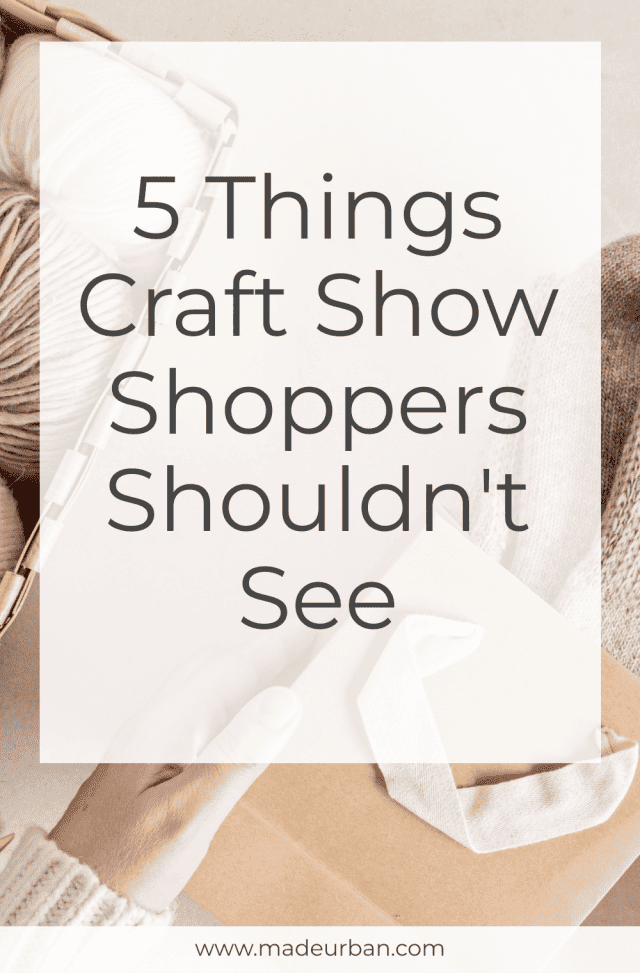

Hey, I’m Erin 🙂 I write about small business and craft show techniques I’ve learned from being a small business owner for almost 2 decades, selling at dozens of craft shows, and earning a diploma in Visual Communication Design. I hope you find my advice helpful!


I pinned all you posts!! Really great tips and I’will consider them when I go to a craftbooth! Thanks a lo for all this advice: really helpful.
Greetings from Belgium
Inge
Thanks for reading and pinning Inge! We really appreciate it and are so glad you find our articles helpful 🙂
Rather than count my cash during the show itself, I set up a report on my Square that I can open to see how I’m doing up to that point.
Of course, you need to track all of your sales through the Square, not just the credit cards for this to work.
That’s a great tip Sarah. Quick and easy!
I think the way your photos of retail windows are translated for craft sellers is very clever.
Thanks Fiona! The retail windows are a little more extravagant than a craft fair booth but lots of ideas that can be used on a smaller scale 🙂 Thanks for reading!
As a crafts show organizer I would like to add that people don’t want to see your boxes of supplies, dollies, trash, discount or sale, sale, sale signs or you thinking you are being discreet packing up before the end of the show. We need to shine from opening to closing. Dressing nicely will add to your air of professionalism. I see people sometimes who put together a gorgeous display and forget to look in the mirror. Your outfit each morning is the first art you create each day!
Thanks so much for your input Peggy! Keeping your space tidy is a great point and I couldn’t agree more with dressing the part 🙂
~Erin
Im doing repurposed, upcycled clothing and jewelry. Ive found an infinite amount of people doing the same. How in the world do I put a unique spun on THAT??!!
display is going to count big. As a shopper I need ideas on how to upgrade yesterday’s fashion into today’s statement. Fortunately today world allows for almost anything goes. So when you are creating your display pay attention to color & size. Display you clothing using these 2 factors. Important because a shopper will take a few minutes to look at what you have in a size they are shopping for & to find an accent piece to compliment it. NOTE; They may be shopping for a gift! If you have a rack of assorted skirts or name brand jackets shoppers will pass you by because they do not want to waste time. They will move on because there are so many other booths to visit. I am a resale shopper, retired on a budget. When I go to a store that racks the clothing by color & type only I am shortly discouraged and just walk away. A little advice from the other side. PS. At a craft show how you look reflex how responsible a salesperson you are. coordinate your outfit the day before.
I am working part time now and looking to crafting to help me stay sane. I would love to sell what I craft and am very excited to come across your post on pinterest! I would appreciate any input you have on doing this successfully. My first craft show won’t be until September and I plan to have fall and winter crafts to sell.
Hi Melanie,
Thanks for reading! My blog is full of advice on successfully selling handmade products and I also have a few ebooks on the topics.
https://www.madeurban.com/blog/
https://www.madeurban.com/blog/made-urban-ebooks/
Wishing you the best of luck in your new venture!
Erin
Absolutely excellent article!!!
Thank you so much P.jackson! Glad you enjoyed it 🙂
Just read the article about dos and don’t. Agree with it all but find it hard to chat with my customers so I use a small part of my set up to work on my craft where they can see it. This shows that I really do make the product and it’s a good stepping stone into conversations about custom pieces they can order.
http://Www.facebook.com/nailart5
This is one of the best articles on marketing I have ever seen.
Thanks for posting it.
Excellent article and do and don’t. Good ideas too for display which help produce some ideas. Thank you.
Love these tips! But as a soap seller I can’t legally make the claims you suggest on DO #1 – this makes my soap a cosmetic. Do you have suggestions for legally selling soap?
Hi Sherru,
Thanks for reading! I’m not a soap maker (or lawyer) but I believe you want your soap to fall under the “cosmetic” category. However, you don’t want them to be considered a “drug”, which is when you have much more strict rules and regulations to follow. I have an article here outlining the legalities of selling soap: https://www.madeurban.com/blog/selling_handmade_soap_these_are_the_cosmetic_label/
This article got me excited to start a new side business. Next up, I plan to read your article on selling and the law.
I put on 2 large vendor events a year – 75 vendors in each one. I see everyone that you have talked about!!!! The one on the phone didn’t sell a thing. The guy that makes his own lotions and soaps was out in front of his table giving every one a test sample right there! He sold out!! I try to make rounds all day and talk to vendors. At some booths, I never did find the vendor there!! And I provide sitters in case of potty runs, etc. You are spot on in your article!!!
Excellent article. I have been doing crafts shows since the early 80’s and first impressions make a difference. Also demonstration helps. My craft is wood and 95% of all my work are from my own patterns. People know they are getting an original design and will come back.
Thanks so much for reading and commenting everyone!! Great tips Robin and Rhoda!
~Erin
I’ve been participating in craft shows on and off for 20 years. I’ve read many books and articles on the subject (most is crap, fluff, unrealistic) but this post is hands down the very best advice. You get into the psychology of why people buy and how we can really help ourselves. Thank you sincerely for sharing. I have some thinking and rework to do. You can teach an older dog new tricks!
Wonderful article and information. I can’t wait to click on all the links to learn more.
This is the first I have seen your article. I find it very informative. Also could be used in many different forms of work as well as craft shows. Thank you for all of the suggestions you put forth. Will watch for more.
I have been dreaming of having a booth at a flea market for over twenty years. And your article gave me the confidence to give it a try! Now I just need to narrow down my products. Thanks so much!
Well written thought provoking article! Thanks for sharing!
Getting ready to do my first craft show, I have not seen my craft items at any craft shows before. You have given me many helpful information about my set up. Thank you for all your help